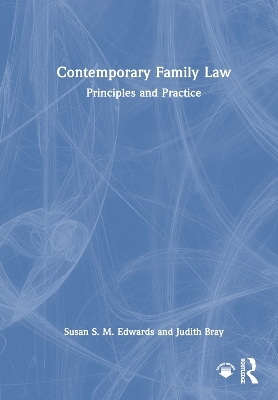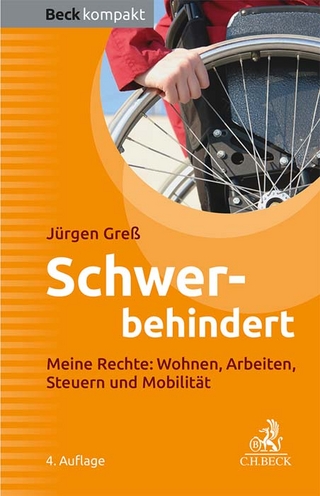
Contemporary Family Law
Routledge (Verlag)
978-1-032-56342-8 (ISBN)
- Lieferbar (Termin unbekannt)
- Versandkostenfrei
- Auch auf Rechnung
- Artikel merken
Taking a fresh and modern approach, Contemporary Family Law: Principles and Practice gives students all the information they need to develop a clear understanding of this fascinating area of the law. Covering the very latest developments in family law, each chapter uses contemporary cases as a window to introducing core legal concepts, principles and developments, emphasising the dynamism and evolving nature of family law, in which practitioners, campaigners, law reformers and students all play their part.
Key features include:
Developments in family law are considered not only from a vantage point of judicial decision making but also from the perspective of the contribution made by solicitors, barristers and experts. This encourages students to develop a sense of their own potential agency when as future practitioners they represent their clients and engage in law reform
In considering legal argument and case determination, the book places equality front and centre, including access to justice
Each chapter provides further reading with online links and URLs and a set of self-test questions, including problem scenarios and discursive essay questions. Each form of assessment ref lects the levels of educational attainment and mirrors testing techniques relevant to academic examination and legal professional and vocational practice courses
This uniquely contemporary textbook will be essential reading for all students of family law.
Susan S. M. Edwards is Professor of Law at Northumbria University, Barrister, Door tenant at Red Lion Chambers London, expert witness, Emerita Professor of Law University of Buckingham, and has taught and published extensively in the area of family law, homicide, partner and child abuse and gender and human rights. Judith Bray is a Barrister and Emerita Professor of Law at University of Buckingham. With many years’ experience of teaching family law at degree level and for professional examinations, Judith has published extensively on property law and equity and trusts, particularly rights in the family home.
Preface xiii
List of abbreviations xv
Table of cases xvii
Table of statutes xix
Table of statutory instruments xxi
1 Introduction to family law 1
What is family law? 1
Rights and obligations 3
Evolving definitions of the family 4
Excluded relationships 5
Challenges to family law 6
The international family 8
Human rights 9
International conventions 9
Challenges to the operation of family justice 10
Judging judges and justice 10
Accountability 12
Organisation of the text 12
References 13
2 State intervention in personal relationships 14
Form v Function 15
Definitions and formation of relationships 19
Self-test questions 45
References 45
Further reading 46
3 Nullity and its consequences 48
Nullity: An important concept 48
Void or voidable relationships 49
Self-test questions 72
References 73
Further reading 74
4 Acquisition and protection of rights in the family home 75
The family home: An overview 75
Self-test questions 106
References 107
Further reading 108
5 Protecting adults from domestic abuse – the civil remedies 109
Contemporary definitions and very public cases 110
History: challenging the common law 115
Domestic abuse incidence and the criminal law 119
Civil remedies for domestic violence and abuse 123
Family Law Act 1996, Part IV s 33–41, 43–49: occupation rights 124
Family Law Act 1996, Part IV: s 42–42A, 43–49: non-molestation orders 131
Other forms of abuse and legal protections 136
More protection needed: closing remarks 141
Self-test questions 145
References 146
Further reading 150
6 Ending relationships 152
The new procedure 161
Civil partnerships 168
Self-test questions 170
References 170
Further reading 171
7 Financial consequences of relationships 172
Part I ownership of personal property and rights to maintenance during a relationship 173
Part II financial consequences of ending the relationship 178
Self-test questions 223
References 224
Further reading 225
8 The elderly, their rights in family life and death and its consequences 227
Social care of the elderly 231
On whom should the burden of care fall? 231
Abuse of the elderly 232
Self-test questions 252
References 252
Further reading 254
9 Family life – parents and carers: From parental rights to responsibilities 255
Parenting histories – the exclusive father 257
Demise of paternal authority and rise of parental responsibility 259
Today – who is a parent in fact? 263
Genetic – biological parents and the natural parent presumption 265
Gestational – parentage 268
Social and psychological parentage – the importance of attachment 277
Legal parents and parental responsibility 281
Parental responsibility: who is entitled? 285
Court orders parental responsibility 286
Other parents – stepmothers and stepfathers’ parental responsibility 294
Concluding remarks – family rights – article 8 ‘family life’ 295
Self-test questions 296
References 297
Further reading 299
10 Adoption – only permissible if nothing else will do 301
History of UK adoption 303
The legislation 304
Who can be adopted? And who can adopt 304
The current legal framework 307
Court orders 313
The placement order 319
Adoption order – when nothing else will do 321
Adoption or special guardianship order 322
Other orders 329
International adoption 331
Closing remarks: ‘nothing else will do’ 334
Self-test questions 337
References 338
Further reading 340
11 Adolescent autonomy – the right to decide and to participate in court proceedings 342
Rights of the child and adolescent: general principles and sources of law 343
Under 16-year-olds and the Gillick competence precept 350
Applying Gillick – how can an adolescent acquire competence? 353
‘Gillick competence’: only a right to refuse consent? 355
Refusing saying no no no to blood, organs, sedation 359
Wardship – trump card 363
Adolescent participation in legal proceedings 367
Judicial activism or judicial paternalism 373
End game – a matter for Parliament! 376
Self-test questions 377
References 378
Further reading 380
12 Putting child welfare first in child ‘custody’ and private disputes 381
Child custody throughout history 383
When parents fall out today 385
Partnership – conciliation and mediation 387
The legal framework 388
Guiding principles of the Children Act 389
The welfare checklist: six factors 391
Section 8 – the orders 400
Child arrangement order (CAO) for residence 401
Child arrangement order (CAO) for contact 403
Abusive partners and contact strategies 406
Specific issue order 410
Prohibited steps order 412
International relocation and abduction 414
International law 416
A legitimacy crisis in private law 425
Self-test questions 427
References 428
Further reading 431
13 The limitless jurisdiction of wardship 433
Contemporary high profile wardship cases 434
From the ancient to the modern jurisdiction of wardship 434
The inherent jurisdiction 436
The legal framework of wardship 438
Strictly wardship 440
The limitless jurisdiction 445
Practice direction 12d [1,2](b) – orders to prevent undesirable association 448
Practice direction 12d [1.2](c) – orders relating to medical treatment 12d [1.2](c) 450
Practice direction 12j (pd) wardship, abduction and habitual residence 459
Reform of wardship 463
Self-test questions 463
References 464
Further reading 465
14 Child protection: Local authority, the court and public law procedure 467
High profile cases 468
Child abuse – an historical denial 468
Abuse – from discrete incidents to totality context 472
Child abuse – an epidemic 478
The legal and procedural framework of safeguarding 479
Orders during the preliminary stage 490
Court interim orders 497
Child protection requires truth – fact finding expert opinion and the truthful parent 498
Concluding remarks – how well is the local authority doing in child protection? 504
Self-test questions 505
References 506
Further reading 509
15 ‘Significant harm’: Judicial interpretations and state politics 510
Social policy and the threshold 512
The legal framework 513
Evidence – burden and standard 515
What conduct falls under ‘significant harm’ s 31(10)? 516
Present significant harm: a temporal question 524
General principles pre-emptive strike 526
The much contested case – Re H and R (1995) ‘likely to suffer’ 528
Care proceedings applications of sexual abuse in the shadow of Re H and R 530
Truth – uncertain perpetrators and physical injury 534
Supervision orders 543
Finale – how better can we protect children? 547
Self-test questions 549
References 550
Further reading 552
16 Financial provision for children 554
Background to child support 555
Child support: history 557
Self-test questions 579
References 579
Further reading 580
Index 582
| Erscheinungsdatum | 05.12.2024 |
|---|---|
| Zusatzinfo | 15 Tables, black and white |
| Verlagsort | London |
| Sprache | englisch |
| Maße | 174 x 246 mm |
| Themenwelt | Recht / Steuern ► Allgemeines / Lexika |
| Recht / Steuern ► Arbeits- / Sozialrecht ► Sozialrecht | |
| Recht / Steuern ► EU / Internationales Recht | |
| Recht / Steuern ► Privatrecht / Bürgerliches Recht ► Familienrecht | |
| ISBN-10 | 1-032-56342-7 / 1032563427 |
| ISBN-13 | 978-1-032-56342-8 / 9781032563428 |
| Zustand | Neuware |
| Informationen gemäß Produktsicherheitsverordnung (GPSR) | |
| Haben Sie eine Frage zum Produkt? |
aus dem Bereich


